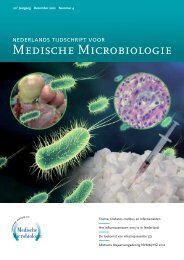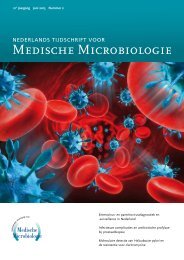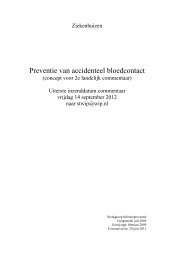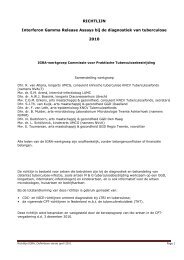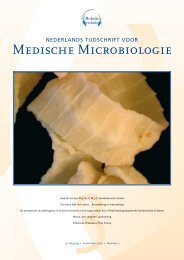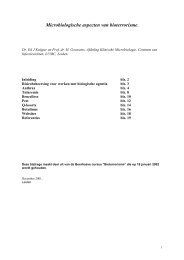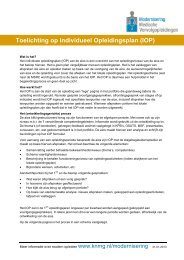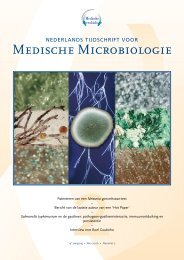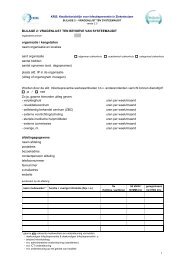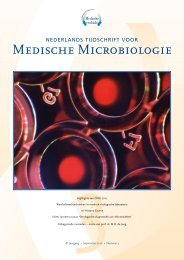Supplement bij veertiende jaargang, april 2006 - NVMM
Supplement bij veertiende jaargang, april 2006 - NVMM
Supplement bij veertiende jaargang, april 2006 - NVMM
You also want an ePaper? Increase the reach of your titles
YUMPU automatically turns print PDFs into web optimized ePapers that Google loves.
15.01<br />
Molecular typing of bacterial pathogens reveals a spectrum<br />
from clonal to panmictic population structures<br />
L.M. Schouls<br />
National institute of Public Health, Laboratory for Vaccine-<br />
Preventable Diseases, Bilthoven<br />
Introduction: Strain typing is an integral part of epidemiological<br />
investigations of bacterial infections. However, strain<br />
typing may also serve to study the composition of bacterial<br />
populations and the impact of human interference on these<br />
populations. Methods to distinguish bacterial strains have<br />
improved dramatically over the last decade, mainly due to<br />
the introduction of molecular typing technology.<br />
Methods: Many studies have been performed to assess<br />
source and contacts in outbreaks of community acquired or<br />
nosocomial bacterial infections. Mostly these studies rely<br />
on rapid, easy to perform band based typing methods like<br />
pulsed-field gel electrophoresis and restriction fragment<br />
length polymorphism. However, more recent and reliable<br />
typing technology, such as multi-locus sequence typing<br />
(MLST), relies on DNA sequence information. This<br />
portable technique seems to be better suited to create<br />
(inter)national databases required for population studies.<br />
Furthermore, the availability of whole genome sequences<br />
over a large number of bacterial species has enabled<br />
the development of microarrays to perform comparative<br />
genome hybridizations.<br />
Results: MLST has yielded a number of publicly available<br />
databases with typing results that have been used to<br />
study bacterial populations. Some of the best studied<br />
bacterial species are Neisseria meningitidis and Streptococcus<br />
pneumoniae. Analysis of the MLST databases showed that<br />
species like Helicobacter pylori are extremely diverse due<br />
to constant lateral transfer and genome reshuffeling. In<br />
other species like N. meningitidis where DNA is exchanged<br />
and recombined to a lesser extend MLST has proven to be<br />
extremely useful for population studies. However, some<br />
species like Bordetella pertussis hardly exchange DNA<br />
and have a nearly uniform population often referred to<br />
as clonal. For highly variable and clonal species MLST is<br />
unsuitable and other typing methods are required.<br />
Conclusion: Molecular typing techniques, particularly<br />
MLST, have revealed that bacterial species may have<br />
population structures that vary from panmictic to clonal.<br />
15.02<br />
Phylogenomic Analysis of Enterococcus faecium (efm) Using<br />
Mixed Whole genome Microarray Technology Discerns a<br />
globally Dispersed Hospital Clade<br />
H.L. Leavis1,2 , R.J.L. Willems1 , W.J.B. van Wamel1 , F.H.<br />
Schuren2 , A.C. Fluit1 , M.J.M. Bonten1 1 2 UMC Utrecht, Eijkman-Winkler Institute, Utrecht, TNO,<br />
Quality of Life, Zeist<br />
Ned Tijdschr Med Microbiol <strong>2006</strong>; 4:<strong>Supplement</strong><br />
S49<br />
Introduction: Efm, ubiquous colonizers of humans and<br />
animals, have emerged as nosocomial pathogens in the last<br />
decade. Comparative phylogenomic analysis (CPA) using a<br />
mixed whole genome microarray was used to elucidate the<br />
population structure of Efm, using 97 Efm isolates from<br />
different backgrounds (hospital outbreaks, hospitalized<br />
patients, healthy subjects and animals) typed by multilocus<br />
sequence typing (MLST).<br />
Methods: A shotgun library constructed of DNA from<br />
9 Efm strains and additional PCR products (virulence<br />
genes and resistance markers) were spotted. Mixtures of<br />
Cy5 labeled DNA of the 97 Efm isolates and Cy3 labeled<br />
DNA of the library strains were hybridized. 3474 inserts<br />
met quality criteria and were analyzed. 151 hospital clade<br />
associated inserts were amplified, sequenced and blasted<br />
in GenBank. Genomic mosaicism was visualized using<br />
split decomposition analysis (SDA) and a Bayesian-based<br />
algorithm on binary data was used to study phylogeny.<br />
Character evolution was studied with maximum likelihoodbased<br />
models.<br />
Results: 1183 inserts (34 %) were conserved among all Efm<br />
strains. CPA identified a clade, supported by Bayesian<br />
probabilities (p=1), containing all outbreak-associated<br />
strains and closely resembling the previously described<br />
MLST-based Clonal Complex-17. 447 inserts (13%) were<br />
associated with this clade. The predicted most prominent<br />
inserts of this clade encoded a mutator type transposase<br />
and a predicted metal-dependent hydrolase (98% sensitive,<br />
100% specific). Clade-specific inserts (specificity > 78%,<br />
sensitivity 40-94%) included membrane proteins (n=8),<br />
hypothetical (n=26), resistance and (n=3), regulatory genes<br />
(n=7), mobile elements (n=35), phage (n=6) and plasmid<br />
genes (n=6). The genes were mainly located on 2 contigs<br />
of the unfinished Efm DO genome. In SDA presence<br />
and absence of genes on these contigs was inconsistent<br />
with a branched phylogeny, indicating a highly mosaic<br />
structure.<br />
Conclusion: These findings demonstrate the evolution<br />
of a specific Efm subpopulation, associated with hospital<br />
outbreaks worldwide, and characterized by mobile<br />
elements, regulatory and potential virulence genes and a<br />
highly mosaic structure.<br />
15.03<br />
non-typeable methicillin-resistant Staphylococcus aureus<br />
form a clonal cluster which seems to be related to pig<br />
farmers and pigs<br />
X.W. Huijsdens 1 , E. Spalburg 1 , M.G. van Santen-Verheuvel 1 ,<br />
M.E.O.C. Heck1 , G.N. Pluister1 , B.J. van Dijke2 , A. Voss3 ,<br />
W.J.B. Wannet1 , A.J. de Neeling1 1 2 RIVM, LIS-BBT, Bilthoven, St.Jansgasthuis, Weert,<br />
3Canisius-Wilhelmina Hospital, Medical Microbiology,<br />
Nijmegen




